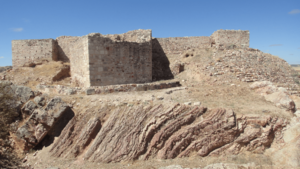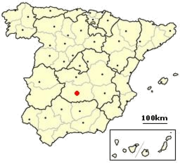Battle of Alarcos facts for kids
Quick facts for kids Battle of Alarcos |
|||||||
|---|---|---|---|---|---|---|---|
| Part of the Reconquista | |||||||
 Alarcos castle |
|||||||
|
|||||||
| Belligerents | |||||||
Castilian rebels |
|||||||
| Commanders and leaders | |||||||
Pedro Fernández de Castro |
|||||||
| Strength | |||||||
| Order of Évora Order of Santiago Undetermined ~ 10,000 knights in heavy armor Modern estimate: More than 25,000 |
Marinid volunteers Zenata Archers Hintata Andalusian forces undetermined Modern estimate: 20,000-30,000 |
||||||
| Casualties and losses | |||||||
| According to the number of men of 300,000, according to Almohad sources, there may have been 250,000 casualties. Figures tremendously exaggerated in the same way by the sources of the time | 5,000 - 20,000 | ||||||
The Battle of Alarcos took place on July 18, 1195. It was a major fight between the Almohads, led by their ruler Abu Yusuf Ya'qub al-Mansur, and the Christian forces of the Kingdom of Castile, led by King Alfonso VIII of Castile. The battle happened near Alarcos, a town in what is now Spain.
The Almohads won this battle. The Castilian army was defeated and had to retreat to Toledo. After their victory, the Almohads took back several important towns like Trujillo, Montánchez, and Talavera. This battle was a big moment in the Reconquista, which was a long period when Christian kingdoms tried to take back land from Muslim rule in the Iberian Peninsula.
Contents
Why the Battle Happened
The Truce Ends
In 1189, the Almohad ruler, known as Caliph Yaqub al-Mansur, had returned from his capital city, Marrakesh. He went to fight the Portuguese, who had captured the city of Silves with help from other Christian groups. Yaqub al-Mansur successfully took Silves back and then returned to Marrakesh.
After this, the Almohads and the Christian kings of Castile and León agreed to a ceasefire, called an armistice. This meant they would stop fighting for a while.
Castile Attacks
When the armistice ended, King Alfonso VIII of Castile heard that Yaqub al-Mansur was very sick in Marrakesh. He also heard that Yaqub's brother, Abu Yahya, who governed Al-Andalus (the Muslim-ruled parts of Spain), had gone to Marrakesh to try and become king himself.
Thinking the Almohads were weak, Alfonso VIII decided to attack the region of Seville in 1194. A strong army, led by the archbishop of Toledo and including the military Order of Calatrava, raided the area.
Almohad Response
Yaqub al-Mansur quickly dealt with his brother's attempt to take power. With his empire now safe, he had no choice but to lead an army against the Christians. They were threatening the northern parts of his lands.
On June 1, 1195, Yaqub al-Mansur landed in Tarifa. His main Almohad army marched through Seville and reached Cordova by June 30. They were joined by local troops and even some Christian cavalry led by Pedro Fernández de Castro. Pedro Fernández de Castro had a personal disagreement with the Castilian king.
March to Alarcos
On July 4, Yaqub's army left Cordova. They crossed a mountain pass called Muradal and moved into the plain of Salvatierra. A group of knights from the Order of Calatrava tried to find out how strong the Almohad army was. They were almost wiped out by Muslim scouts but managed to send information back to the Castilian king.
Alfonso VIII gathered his forces in Toledo. He then marched to Alarcos (called al-Arak in Arabic), which was near the Guadiana River. This place was the southern edge of his kingdom, and a fortress was being built there. Alfonso wanted to block the Almohads from reaching the rich Tagus valley. He decided not to wait for more soldiers that the Kings Alfonso IX of León and Sancho VII of Navarre were sending.
On July 16, the Almohad army appeared. Yaqub al-Mansur chose not to fight that day or the next. He wanted his soldiers to rest. But early on Wednesday, July 18, the Almohad army got ready for battle. They formed their lines around a small hill called La Cabeza, not far from Alarcos.
The Battle of Alarcos
Almohad Battle Plan
Yusuf Ya'qub al-Mansur put his vizier (a high-ranking official), Abu Yahya ibn Abi Hafs, in charge of a very strong front group. The first line had volunteers from the Bani Marin tribe, led by Abu Jalil Mahyu ibn Abi Bakr, along with many archers and the Zenata Tribe. Behind them, on the hill, was the vizier with the Amir's (ruler's) banner and his personal guards from the Hintata tribe.
To the left, the Arab army was led by Yarmun ibn Riyah. To the right, the forces from al-Andalus were led by Caid Ibn Sanadid. Yusuf Ya'qub al-Mansur himself commanded the rear group. This group had the best Almohad soldiers, including the black guard (soldiers of African descent). It was a huge army, much stronger than Alfonso had thought.
Castilian Attack
The Castilian king, Alfonso, put most of his heavy cavalry (about 8,000 strong) into one tight group. He gave command of this group to Diego López de Haro, a lord from Vizcaya. The king himself would follow with the foot soldiers (infantry) and the Military Orders.
The charge by the Christian cavalry was a bit messy. The knights crashed into the Zanatas and Bani Marin soldiers and scattered them. Drawn by the Amir's banner, they charged up the hill. Vizier Abu Yahya was killed, and most of the Hintata soldiers died trying to protect themselves.
Most of the knights then turned left. After a tough fight, they defeated the al-Andalus forces of Ibn Sanadid. Three hours had passed. It was afternoon, and the intense heat, tiredness, and constant arrows hitting them started to wear down the armored knights.
The Turning Point
Meanwhile, the Arab forces on the right, led by Yarmun, had been moving around the Castilian army's side and rear. At this point, the best of the Almohad forces attacked. The sultan himself was clearly visible in the front lines. The knights were almost completely surrounded.
Alfonso VIII moved forward with all his remaining soldiers into the fight. But he found himself attacked from all sides and under a shower of arrows. For a while, he fought hand-to-hand. Finally, his bodyguards almost forced him to leave the battle. They fled towards Toledo.
The Castilian foot soldiers were destroyed, along with most of the Military Orders that had supported them. The Lord of Vizcaya, Diego López de Haro, tried to fight his way through the enemy. But he eventually had to find safety in the unfinished fortress of Alarcos with only a few of his knights.
Surrender and Losses
The castle was surrounded. About 3,000 people were trapped inside, including women and children. The king's enemy, Pedro Fernández de Castro, who had not fought much in the battle, was sent by the Amir to discuss a surrender. López de Haro and the survivors were allowed to leave. However, they had to leave 12 knights as hostages to ensure a large ransom would be paid.
The Castilian army on the battlefield was completely destroyed. Many important people were killed. These included three bishops (from Avila, Segovia, and Siguenza), Count Ordoño García de Roda and his brothers, Counts Pedro Ruiz de Guzmán and Rodrigo Sánchez, and the leaders of the Order of Santiago and the Portuguese Order of St. Benedict. The Muslims also had losses, including the death of the vizier and Abi Bakr, who led the Bani Marin volunteers. Abi Bakr died from his wounds the next year.
After the Battle
Impact on Castile
The outcome of the Battle of Alarcos greatly affected the Kingdom of Castile for several years. All the nearby castles either surrendered or were left empty. These included Malagón, Benavente, Calatrava, Caracuel, and Torre de Guadalferza. The path to Toledo was wide open for the Almohads.
However, Abu Yusuf Yaqub al-Mansur went back to Seville to recover from his own significant losses. There, he took the new title of al-Mansur Billah, which means 'The one victorious by God'.
Almohad Raids and Alliances
For the next two years, al-Mansur's armies raided and damaged areas like Extremadura, the Tagus valley, La Mancha, and even the region around Toledo. They attacked towns such as Montánchez, Trujillo, Plasencia, Talavera, Escalona, and Maqueda. Some of these attacks were led by the renegade (someone who has abandoned their group) Pedro Fernández de Castro.
Even though these raids caused a lot of damage, they did not lead to the Almohads gaining much new land. However, Almohad diplomacy did manage to form an alliance with King Alfonso IX of León. This king was angry because the Castilian king had not waited for him before the Battle of Alarcos. The Almohads also got Navarre to stay neutral. But these alliances only lasted for a short time.
Al-Mansur's Departure and Legacy
Eventually, the caliph began to lose interest in the affairs of the Iberian Peninsula. He was not in good health, and he felt that his goal of keeping control over al-Andalus was a complete success. In 1198, he returned to Africa. He died in February 1199.
However, the success of the Battle of Alarcos did not last forever. Sixteen years later, the next Almohad caliph, Muhammad al-Nasir, tried to build on this victory with a new attack in Spain. But he was defeated at the Battle of Las Navas de Tolosa. This later battle was a major turning point that led to the end of Muslim rule in the Iberian Peninsula. The Almohad Empire itself fell apart a few decades later.
See also
 In Spanish: Batalla de Alarcos para niños
In Spanish: Batalla de Alarcos para niños


